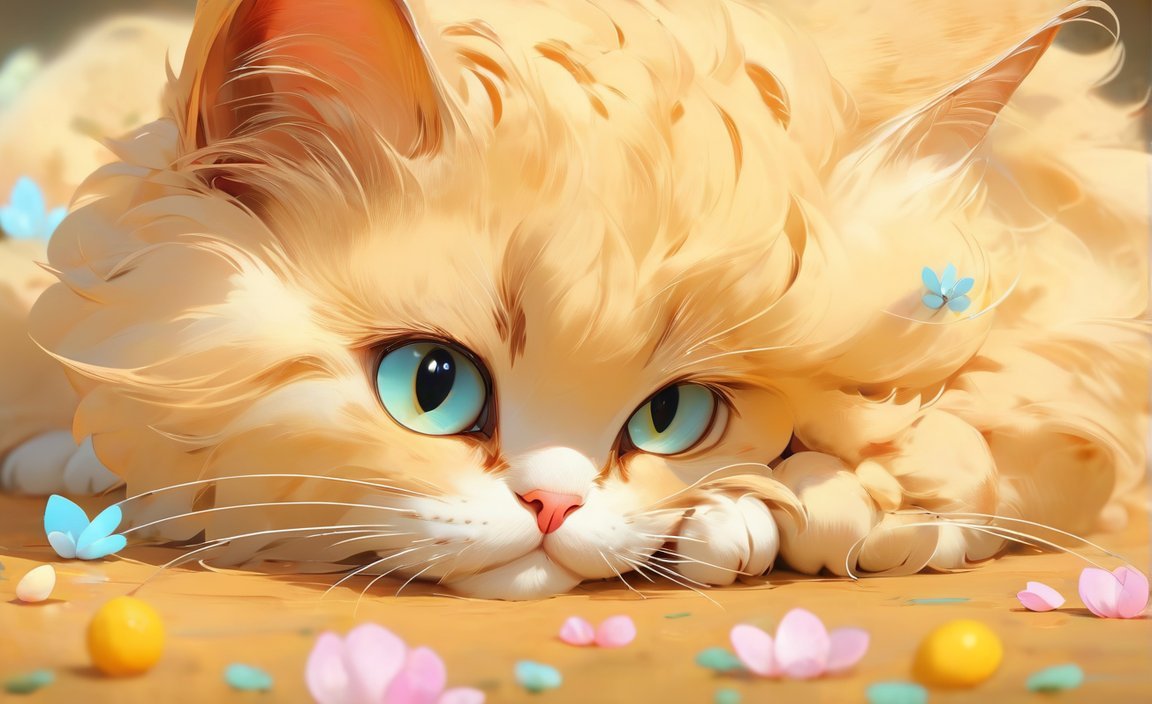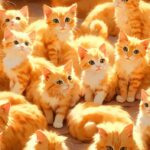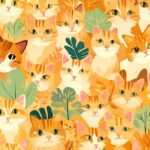If you’ve ever found yourself wondering about the mysterious world of cats and kittens, get ready to be whisked away on a captivating journey. In this article, we will delve into the enchanting realm of felines, uncovering a plethora of amazing facts about these mesmerizing creatures. From their remarkable agility to their unique communication methods, prepare to have your mind blown as we unravel the astonishing secrets of cats and kittens.
Key Takeaways:
- In 1888, over 300,000 mummified cats were found in an Egyptian cemetery and used as fertilizer.
- The largest known litter of kittens ever produced was 19, with 15 of them surviving.
- Cats that are not specific breeds can be called ‘domestic shorthair’ or ‘domestic longhair’.
- A young cat is called a kitten, a female cat is a queen, and a male cat is a tom.
- A group of kittens is called a kindle.
- 30%-50% of cats lack the gene that makes them react to catnip.
Amazing Facts About Cats and Kittens

300,000 Mummified Cats
Did you know that in 1888, over 300,000 mummified cats were discovered in an Egyptian cemetery? These ancient feline remains were actually used as fertilizer by farmers in England and the U.S. Imagine stumbling upon such a fascinating and unusual sight! It truly showcases the deep bond between humans and cats throughout history.
The Largest Litter Ever
When it comes to kittens, we often marvel at their adorable nature. But did you know that most cats give birth to litters of one to nine kittens? However, the largest known litter ever produced was a staggering 19 kittens! Even more incredible, 15 of these tiny bundles of joy survived. Just picturing such a large and lively litter is enough to bring a smile to anyone’s face.
Domestic Shorthairs and Longhairs
Have you ever wondered how cats are categorized? While specific breeds of cats have their own distinct names, cats that don’t belong to any specific breed are referred to as ‘domestic shorthair’ (DSH) or ‘domestic longhair’ (DLH). This simple classification allows us to appreciate the diversity and uniqueness of our beloved feline companions.
Kittens, Queens, and Toms
A young cat is called a kitten, but did you know that female and male cats also have specific names? A female cat, capable of having kittens, is known as a queen, while a male cat, able to father kittens, is called a tom. These terms add a touch of regality to our feline friends and remind us of their inherent grace and beauty.
A Kindle of Kittens
What’s cuter than a single kitten? A group of kittens, of course! When several adorable furballs are seen together, they are collectively known as a kindle. Just envision a bunch of playful and energetic kittens, tumbling over one another and filling your heart with joy. It’s truly a sight to behold!
Revealing a Unique Sensitivity
Cats have always been known for their curious behavior. Among their quirks, their reactions to catnip are often a topic of intrigue. But did you know that not all cats are affected by catnip in the same way? Approximately 30% to 50% of cats lack the gene that makes them react to this fascinating plant. So if your feline friend remains unfazed by catnip’s charms, there’s nothing to worry about – it’s just part of their unique genetic makeup.
These amazing facts about cats and kittens add another layer of wonder to the already captivating world of feline companions. From mummified cats being used as fertilizer to the diverse classifications for feline breeds, there is always something new and breathtaking to learn about our furry friends. So, next time you curl up with your favorite cat, think about these incredible facts and appreciate the fascinating nature of these magnificent creatures.
Sources:
– FactRetriever (www.factretriever.com/cat-facts)
– Kids Kiddle (kids.kiddle.co)
– Litter Robot (www.litter-robot.com/blog/30-fascinating-cat-facts/)
Check out these amazing facts about aquatic animals! amazing facts about aquatic animals
Discover fascinating details about cats and dogs with these incredible facts! amazing facts about cats and dogs
Explore the wonders of the ocean with these mind-blowing facts about marine animals! amazing facts about marine animals
Dive into the world of marine life and uncover amazing facts that will leave you in awe! amazing facts about marine life
Cats have a specialized grooming technique using their tongue.

Cats are fascinating creatures with a wide range of unique traits, one of which is their specialized grooming technique using their tongue. This grooming method involves their tongue’s remarkable structure and serves multiple purposes. Let’s delve into the intriguing world of cat grooming and explore the amazing facts associated with it.
The Incredible Design of a Cat’s Tongue
A cat’s tongue is an extraordinary tool for self-grooming. Covered in hundreds of tiny backward-facing spines called papillae, it has a rough texture that serves a specific purpose. These papillae spikes act like a built-in comb, effectively lifting up dust, loose hair, dry skin, and other debris that may accumulate on their fur. The spines are made of keratin, the same material found in human nails and hair, providing durability and strength to the tongue’s grooming function.
A Multifunctional Grooming Technique
Cats groom themselves for various reasons beyond mere cleanliness. One of the primary purposes of grooming is to regulate their body temperature. Through licking, cats create moisture on their fur, which helps cool them down in hot weather. Additionally, this self-grooming process stimulates circulation, enhancing blood flow to their skin and ensuring overall wellbeing.
The Art of Untangling and Removing Loose Hair
The stiff papillae of a cat’s tongue are incredibly adept at untangling fur and removing loose hair from their coat. As cats go about their grooming routine, these specialized spines work their way through their fur, catching any loose hairs and eliminating tangles. This not only contributes to a sleek and well-groomed appearance but also prevents the formation of hairballs, which can be uncomfortable for our feline friends.
Flexibility and Reach
One of the unique traits of a cat’s body is its flexibility and supple nature. This flexibility extends to their grooming process as well. Cats can contort their bodies into various positions, allowing them to reach all parts of their body for grooming. From their head to their tail, cats meticulously groom every inch of their fur, ensuring it remains clean, untangled, and well-maintained.
Not Only Domestic Cats
The specialized tongue grooming technique isn’t limited to our beloved domestic cats. Wild big cats, such as tigers and lions, possess the same type of tongue with papillae spines. It is a universal feature among feline species, highlighting the remarkable design and functionality of their tongues throughout the animal kingdom.
In conclusion, cats have a specialized grooming technique using their tongue that showcases their remarkable adaptability. Their tongues, equipped with papillae spikes, serve as built-in combs, untangling fur, removing loose hair, and keeping their coat in pristine condition. This self-grooming routine not only maintains cleanliness but also aids in temperature regulation and stimulates circulation. The next time you observe your cat grooming itself, take a moment to appreciate the fascinating nature of this natural process and the incredible design of their tongues.
Key Takeaways:
– A cat’s tongue is covered in hundreds of tiny backward-facing spines called papillae, which function like a built-in comb.
– Cats groom themselves to regulate their body temperature and stimulate circulation.
– The specialized spines on a cat’s tongue untangle fur and remove loose hair from the coat.
– Cats’ bodies are flexible and supple, allowing them to reach all parts of their body for grooming.
– Domestic cats and wild big cats both have the same type of tongue with spines.
Sources:
– Hill’s Pet: Cat Tongues: Everything You Wanted to Know & More
– Cats.com: 10 Little-Known Facts About Your Cat’s Tongue
Kittens: The Journey from Blindness to Hunting Instincts
Kittens are an absolute delight, with their adorable fluffiness and playful antics. But did you know that these little bundles of joy are born blind and deaf, relying solely on touch and smell? It’s a truly remarkable aspect of their early life that sets the stage for their development[^1^].
Sensory Deprivation and Development
During their early days, kittens undergo sensory deprivation as they are born without the ability to see or hear. This deprivation actually plays a crucial role in their development. It allows them to focus on honing their remaining senses, particularly touch and smell. By relying on these senses, kittens become more adept at navigating their surroundings[^1^].
A Rapid Growth Spurt
In their first year of life, kittens go through a remarkable growth spurt. This is why it’s so important to provide them with proper nutrition during this crucial period. To ensure optimal growth and development, newborn kittens should ideally stay with their mother full-time. This allows them to receive the warmth, cleanliness, and nourishment they need. Maintaining a pen temperature of around 72°F is also important to prevent hypothermia, which can be detrimental to their well-being[^2^].
Developing Hunting Instincts Through Playtime
Despite being born blind and deaf, kittens have a natural instinct for hunting, even at a young age. Playtime activities are not only fun for them, but also help sharpen their hunting skills. From chasing toys to pouncing on objects, these activities contribute to their overall growth and development[^1^].
Communication and Finding Their Way
While kittens may not have the ability to hear or see, it’s fascinating how they adapt and communicate using their limited sensory abilities. They navigate their surroundings through scent and touch, encompassing reflexive behaviors. Nestling close to their mother provides warmth and nourishment through suckling, enabling them to thrive in their environment[^3^].
Feeding the Growing Kittens
As kittens go through their growth stages, proper nutrition is essential. According to Royal Canin, newborn kittens should ideally weigh around 2-3% of their mother’s weight at birth. In the first few days, their weight increases by approximately 10% daily. Providing them with a balanced and appropriate diet will ensure they grow into healthy adult cats[^4^].
Key Takeaways:
- Kittens are born blind and deaf, relying solely on touch and smell for navigation and communication.
- Sensory deprivation during their early days allows kittens to focus on developing their remaining senses.
- Rapid growth during the first year necessitates proper nutrition and close maternal care.
- Playtime activities help kittens develop and sharpen their hunting instincts.
- Despite their limited sensory abilities, kittens exhibit remarkable reflexive behaviors and communication skills.
- Providing a balanced diet is crucial for the healthy growth of kittens into adult cats.
Sources:
[^1^]: Fun Facts About Kittens – Share Fun Facts
[^2^]: Kitten growth stages from birth and weaning – Royal Canin
[^3^]: FOUR PAWS – Kittens and Their Development
A Group of Cats is Known as a “Clowder”
Did you know that a group of cats is called a “clowder”? It’s a fascinating term that dates back to the 1500s and has its roots in the Middle English word “clod”, meaning a lump or mass. When three or more cats come together, they form a clowder^1^.
But that’s not the only name for a group of cats. Other terms used include glaring, colony, or litter. When a group of cats is unfamiliar to one another, it’s called a “glaring”^1^. And when we talk about a group of adorable kittens, we can use either “litter” or “kindle” to describe them^1^.
So, the next time you come across a bunch of furry felines, remember that they’re not just individual cats but make up a clowder—a unique and captivating collective.
Key Takeaways:
- A group of three or more cats is called a “clowder”.
- Other terms for a group of cats include glaring, colony, or litter.
- The word “clowder” originates from the Middle English word “clod”, meaning a lump or mass.
- A group of cats unfamiliar to one another is called a “glaring”.
- A group of kittens is either called a “litter” or a “kindle”.
FAQ
Q1: How many kittens can a cat have in a litter?
A1: Cats can have litters ranging from one to nine kittens, with the largest known litter having 19 kittens, of which 15 survived.
Q2: What are the different terms used for a group of cats?
A2: A group of three or more cats is commonly called a clowder, while other terms used to describe a group of cats include glaring, colony, or litter.
Q3: Why are cats called queens and toms?
A3: In the feline world, an entire female cat that is capable of having kittens is called a queen, while an entire male cat that is able to father kittens is called a tom.
Q4: How do cats groom themselves?
A4: Cats groom themselves by using their tongues, which are equipped with papillae spikes that function like a built-in comb. The spines on a cat’s tongue are excellent at untangling fur and removing loose hair from their coat.
Q5: Do all cats react to catnip?
A5: No, approximately 30%-50% of cats lack the gene that makes them react to catnip. If a cat does possess the gene, it usually comes to fruition between 3-6 months of age.
- Sept 31 Myth: Unveiling Calendar Secrets - March 18, 2025
- How Long & Till December 18, 2025: Accurate Countdown Guide - March 18, 2025
- Discover Japanese Artists: A Complete History - March 18, 2025
















